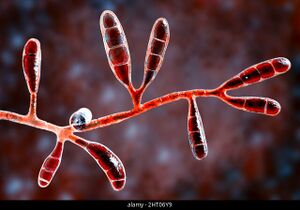Epidermophyton floccosum

Classification
Eukaryote; Fungi; Eurotiomycetes; Onygenales; Arthrodermataceae
Species
|
NCBI: [1]https://www.ncbi.nlm.nih.gov/Taxonomy/Browser/wwwtax.cgi?name=Epidermophyton+floccosum |
Epidermophyton floccosum
Description and Significance
Epidermophyton floccosum is a parasitic, filamentous fungus that commonly causes tinea pedis (athlete's foot), tinea cruris (jock itch), tinea corporis (ringworm), and onychomycosis (nail infections). Cultures present green, brown, yellow, or khaki colorations with folded centers and a suede like appearance. Other features include long hyphae, flat fringe-like peripherals, and thin-walled macroconidia. Macroconidia are identified as large, multinucleate, asexual spores that are commonly short, wide, and smooth in appearance. In contrast to other dermatophytes, E. floccosum lacks the formation of microconidia and rarely causes hair infection. E. floccosum can be found worldwide but is most common in North America and Asian countries, thriving in tropical and subtropical regions. This microorganism can survive in a variety of ordinary environments such as towels, shoes, clothing, showers, and swimming pools for extended durations of time. As E. floccosum is a common cause of superficial infection of the nails and skin, additional research on dermatophytes is needed to develop higher quality antifungal drugs with fewer, less severe side effects.
Genome Structure
The E. floccosum strain ATCC26072 is a circular chromosome with 30,910 base pairs.This strain is thought to be one of the largest genome sizes compared to other dermatophytes with a predicted total of 7,565 genes, 25 tRNAs capable of carrying all 20 amino acids, a large (23S) subunit, and a small (16S) subunit. All genes are located on the same strand. Additionally, 14 genes encode subunits for respiratory chain enzyme complexes along with a ribosomal protein and 5 open reading frames. The total amount of tRNAs corresponds to 5.98% of the genome while the G+C content makes up 23.43%. Ribosomal subunits make up 13.54% and protein-coding exons are 41.98%.
Cell Structure, Metabolism and Life Cycle
E. floccosum is a filamentous spore producing fungi. It contains an usual lipid "characterized as 1(3),2-diacylglyceryl-3(1)-O-4’(N,N,N-trimethyl)homoserine. Its concentration in E. floccossum is approximantly 15% of all polar lipids" within the organism, but its role is still unclear (Yamada, 1979). This lipid is thought to be specific to E. floccosum and other dermatophytes such as Microporum cookei and Trichophyton rubrum do not contain it. E. floccosum obtain its nutrients from keratinized material within its host as its main sources of carbon, nitrogen, phosphorus, and sulfur. The life cycle of E. floccosum is similar to other dermatophytes in that it has an anamorph state and a telemorph state. The anamorph state is the asexual phase where reproduction is achieved through mitosis and the production of spores. The teleomorph state is the sexual phase where reproduction is achieved through the formation of a zygote and undergoing meiosis.
Ecology and Pathogenesis
E. floccosum is commonly found in tropical and subtropical regions, growing at a moderate rate of 10-14 days to maturity. Infection presents itself on human skin but can also infect animals in a similar way forming a parasitic relationship. This microorganism invades tissue and breaks down keratin within skin and nails and is spread through direct contact. Although less common, infection of the eyes (keratitis) is also possible. Overall, virulence is low. Common dermatophyte virulence enzymes include keratinase, protease, phospholipase, lipase and elastase. The main virulence enzymes secreted by E. floccosum include keratinase and serine protease which cause inflammatory response. Identified virulence genes SUB2, SUB3, and SUB7 have been "found in all of the investigated isolates probably implying their indispensable role in infection elicitation" (Khedmati, 2020). Fungi such as E. floccosum can sometimes be difficult to kill but are not incurable. Antifungal agents are commonly used for treatment over the period of roughly two weeks but individual cases will vary. Immunosuppressed subjects may have a longer recovery time due to issues fighting infection.
References
Tambor J, M, Guedes R, Nobrega M, Nobrega F. “The complete DNA sequence of the mitochondrial genome of the dermatophyte fungus Epidermophyton floccosum”. ProQuest. 2006. Volume 49 (Issue 5). p.302-8. doi:https://doi.org/10.1007/s00294-006-0057-2
Janabi Al, A.A. “Study of Characteristic Features of Pleomorphic Epidermophyton floccosum”. Global Journal of Environmental Research. 2009, Volume 3(Issue 2). p.132-134.
Ellis D. “Epidermophyton floccosum”. Mycology Online The University of Adelaide. 2021 https://www.adelaide.edu.au/mycology/fungal-descriptions-and-antifungal-susceptibility/dermatophytes/epidermophyton#:~:text=Epidermophyton%20floccosum%20is%20an%20anthropophilic,RG%2D2%20organism.
Khedmati E, Hashemi Hazaveh S, Bayat M, Amini K. “Identification of subtilisin virulence genes (SUB1-7) in Epidermophyton floccosum isolated from patients with dermatophytosis in Iran”. Science Direct. 2020. Volume 20. https://doi.org/10.1016/j.genrep.2020.100748
Yamada T A, Nozawa Y. “An unusual lipid in the human pathogenic fungus Epidermophyton floccosum”. National Center for Biotechnology Information. 1979. https://doi.org/10.1016/0005-2760(79)90239-x
Elavarashi E, Kindo AJ, Rangarajan S.“Enzymatic and Non-Enzymatic Virulence Activities of Dermatophytes on Solid Media”. National Center for Biotechnology Information. 2017. Volume 11 (Issue 2): DC23-DC25 https://doi.org/10.7860/JCDR/2017/23147.9410
Groll A, Walsh T. “Fungal infection in pediatric patients”. Science Direct. 2009 https://www.sciencedirect.com/topics/agricultural-and-biological-sciences/epidermophyton-floccosum
Author
Page authored by Kira Thomas, student of Prof. Bradley Tolar at UNC Wilmington.
